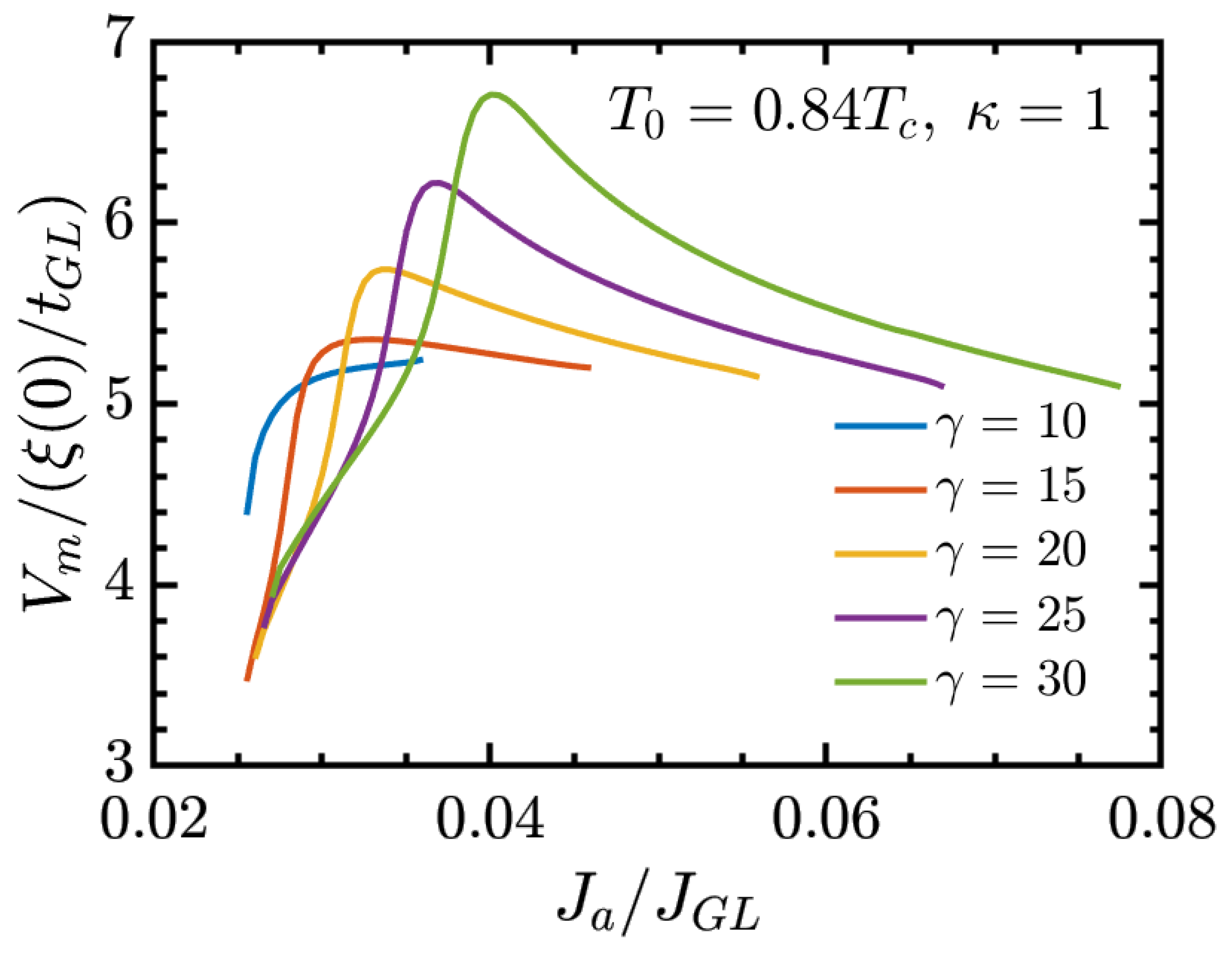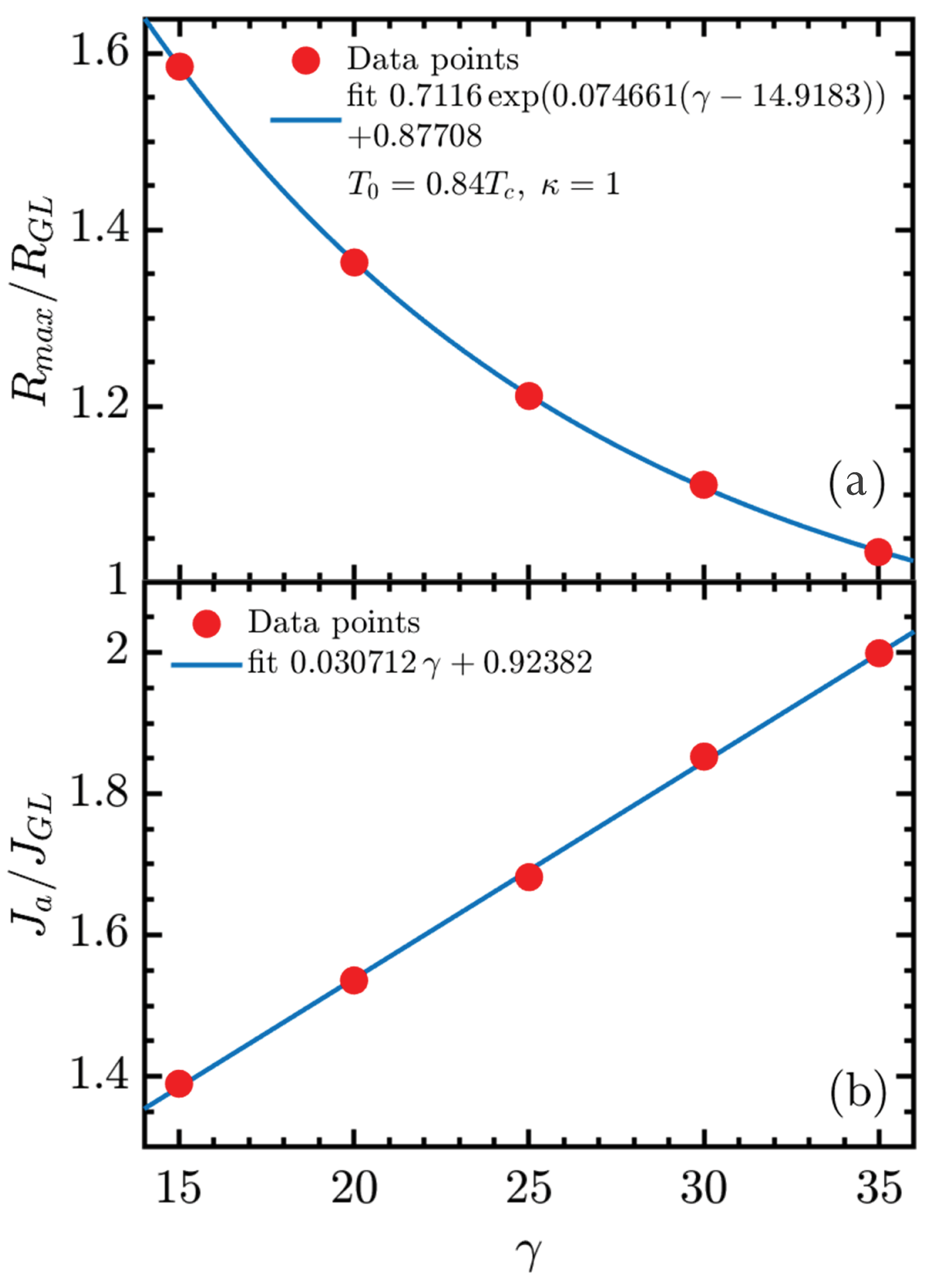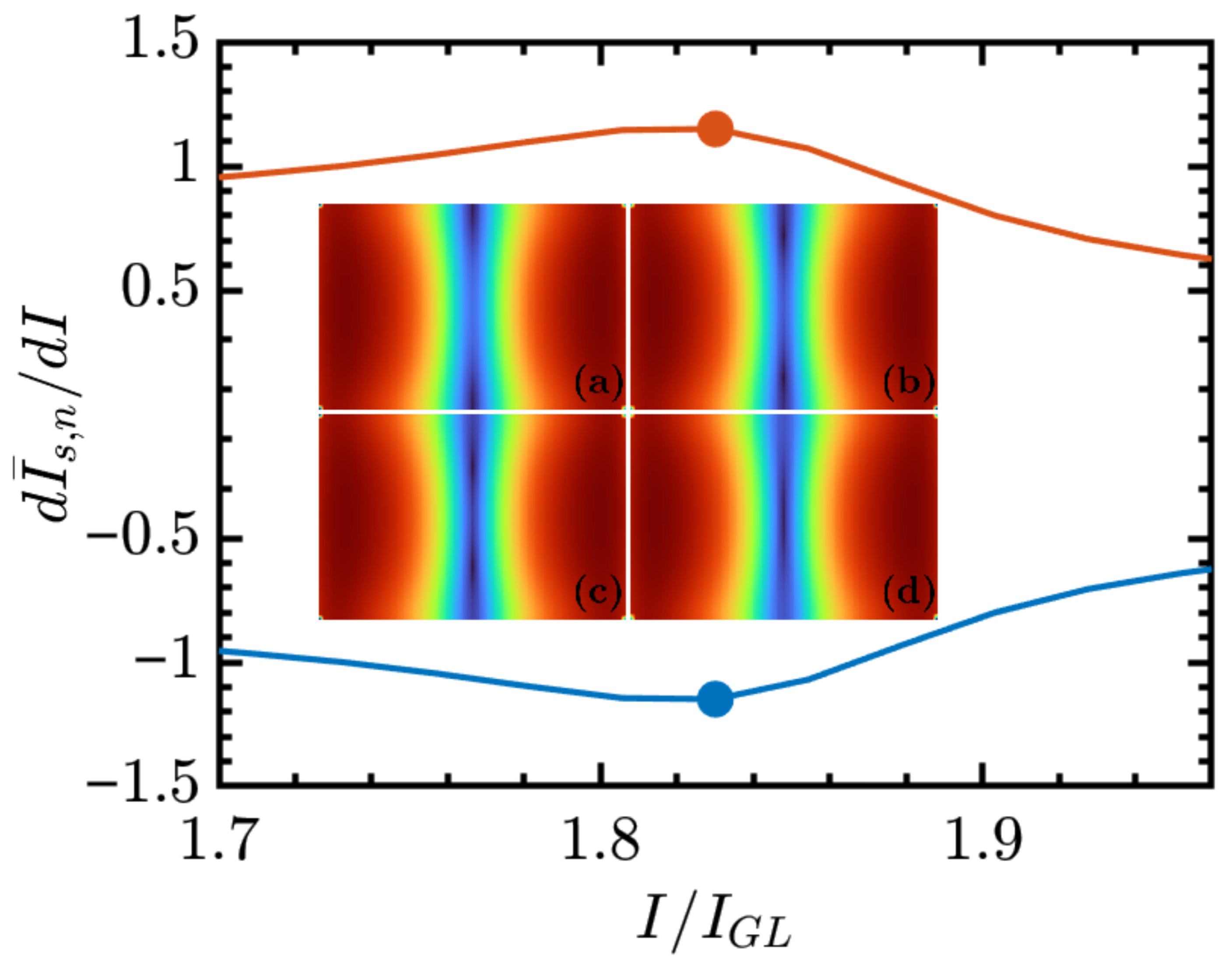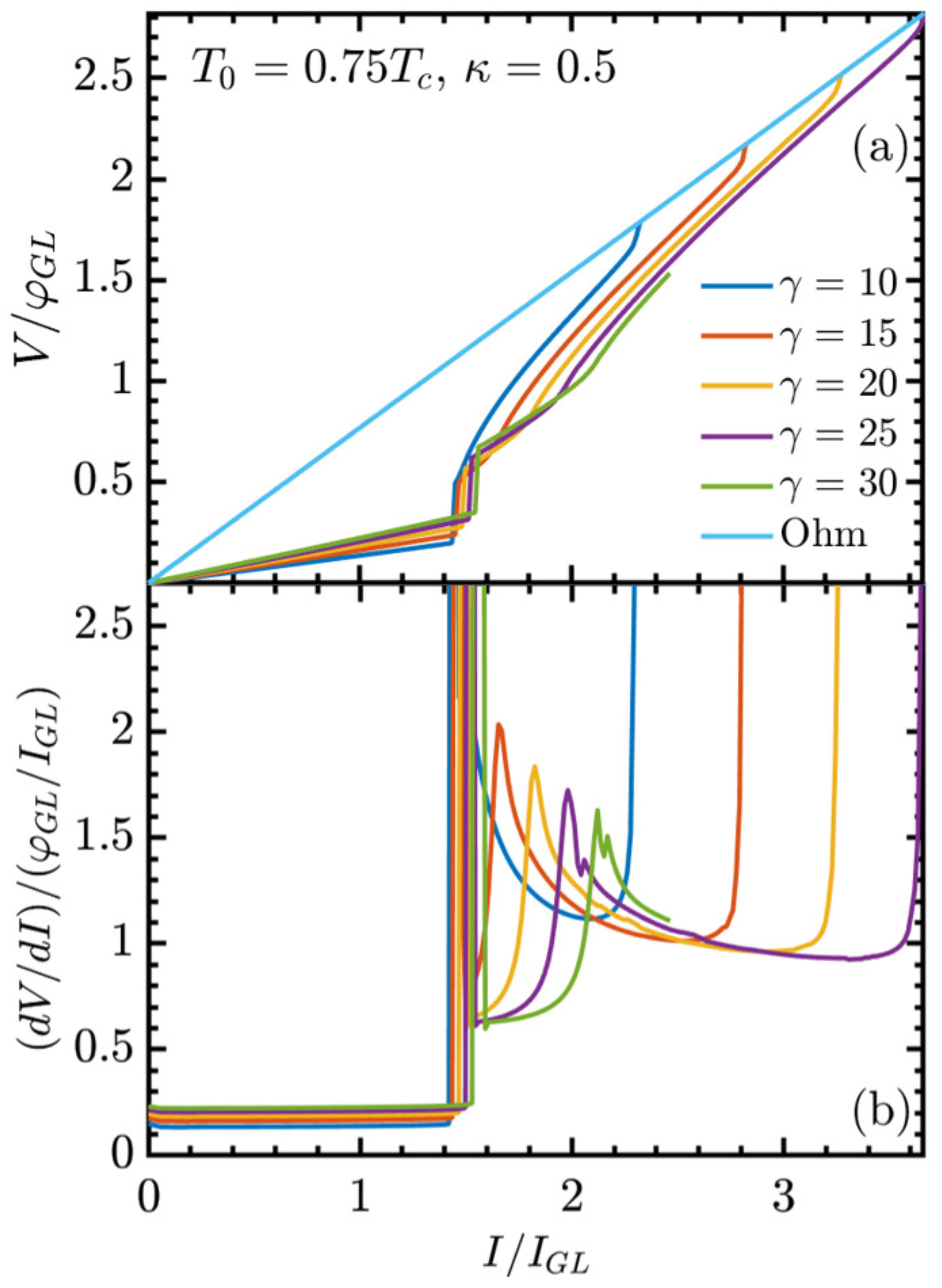1. Introduction
In type-II superconductors, the penetration and motion of vortices induced by magnetic fields or transport currents lead to a local suppression of superconductivity, resulting in a resistive state [
1,
2,
3,
4,
5]. The dynamics of these vortices is significantly influenced by microscopic parameters, particularly the inelastic electron–phonon collision time (
) [
6], which directly affects the relaxation dynamics of the superconducting order parameter [
7,
8]. Within the generalized time-dependent Ginzburg–Landau (GTDGL) framework adopted here, where explicit pinning centers are absent and electron–phonon scattering is taken as the dominant relaxation channel, a shorter
indeed corresponds to faster quasiparticle relaxation, which reduces viscous drag and thereby enhances vortex mobility. This enhanced mobility directly influences the resistive behavior of the material in the flux–flow regime. It must be stressed, however, that this interpretation is not universal: in the cases dominated by strong pinning or by electron–electron scattering, faster relaxation can instead increase damping rather than mobility.
Understanding the role of
is essential for accurately describing vortex dynamics and developing comprehensive models of nonequilibrium phenomena in superconductors. This relaxation scale has been commonly recognized in the broader nonequilibrium superconductivity literature, from studies [
7,
9,
10,
11] to more recent treatments [
12], which discuss its fundamental role in energy relaxation.
The importance of inelastic electron–phonon collision time interactions in the determination of energy relaxation times has been emphasized in foundational studies. Gerasim Eliashberg [
9] highlighted the necessity of incorporating inelastic electron–phonon collision time into theoretical models of nonequilibrium superconducting states, as these collisions are central to dissipation mechanisms and critically shape the resistive response under applied currents or magnetic fields. Furthermore, Michael Reizer and Andrei Sergeev [
6,
13] demonstrated that in pure metals, interactions with transverse phonons significantly accelerate energy relaxation, an effect potentially relevant in superconductors at relaively low temperatures.
Theoretical studies of viscous vortex dynamics have emphasized the influence of the inelastic electron–phonon collision time and impurity concentrations in determining vortex mobility and energy dissipation [
14,
15]. Within this context, the GTDGL theory has provided a robust framework for describing dissipative superconducting states, incorporating both thermal diffusion and intrinsic relaxation mechanisms [
16,
17]. More recently, numerical simulations have reinforced these findings by showing how mesoscopic parameters, such as geometry and boundary conditions, interact with thermal effects to modulate vortex dynamics and resistive behavior in nanostructured superconducting devices [
1,
18].
In thin superconducting films, the kinetics of inelastic electron–phonon collision time relaxation further illustrate the impact of
on resistive behavior. Alexey Bezuglyĭ and Valeriy Shklovskiĭ [
19] discussed how rapidly heated electrons emit nonequilibrium phonons that can escape to the substrate without reabsorption, affecting the thermalization process and, consequently, the dynamics of vortices under nonequilibrium conditions.
During the past decades, significant advances in both experimental and theoretical techniques have improved the understanding of
. Advanced spectroscopic methods, such as time-resolved optical spectroscopy and ultrafast electron microscopy, have enabled direct measurements of relaxation time scales in superconductors, providing detailed insights into inelastic electron–phonon collision time interactions at ultrafast time scales [
20,
21]. Concurrently, the development of new superconducting materials, including quite high critical temperature superconductors and iron-based superconductors, has expanded the understanding of how
varies with the composition and structure of the material. Studies have demonstrated that different crystal structures and electronic densities exhibit different inelastic electron–phonon collision time [
22,
23].
Finally, the time-dependent Ginzburg–Landau theory provides a theoretical framework for understanding how collective behavior emerges in superconductors near critical temperatures. In particular, the slowdown of the order-parameter relaxation near the critical temperature is a universal feature of TDGL dynamics, independent of specific scattering mechanisms. The inelastic electron–phonon time sets the baseline relaxation timescale, but it does not cause the divergence itself; here we use the parameter just as a qualitative control of this timescale.
Building upon this theoretical and computational foundation, in our earlier studies [
24,
25], we explored in detail the three-dimensional (3D) dynamics of vortex–antivortex (V–aV) structures induced by transport currents in mesoscopic type-II superconductors. In Ref. [
24], we employed the full 3D GTDGL formalism to reveal that, for sufficiently thick superconducting films, the self-induced magnetic field generated by the transport current leads to curved V-aV lines that merge into closed vortex loops prior to annihilation. This entirely electrodynamic mechanism, inherently dependent on the sample thickness and the Ginzburg–Landau parameter
, was quantitatively characterized via a geometric criterion based on the aspect ratio of the vortex lines. Furthermore, we proposed an indirect experimental detection strategy based on the measurement of time-averaged magnetic flux at the sample boundaries, offering a practical approach for identifying these elusive topological configurations.
In a subsequent study [
25], we extended that study by coupling the GTDGL equations to the heat diffusion equation, thereby enabling a systematic investigation of thermal feedback effects arising from vortex dynamics. Our results demonstrated that the nucleation and annihilation of closed V–aV pairs act as localized heat sources that significantly alter the temperature distribution within the superconducting film. We further showed that variations in substrate thermal coupling and sample geometry strongly influence the onset of the resistive state, the associated hysteresis in the characteristics
I–
V, and the overall stability of the superconducting phase under nonequilibrium conditions.
The present study advances this investigation program by incorporating a microscopic description of quasiparticle relaxation through the explicit inclusion of inelastic electron–phonon collision time into the GTDGL framework. By systematically varying the dimensionless parameter , with the superconducting gap and ℏ the reduced Planck constant, we examine how inelastic electron–phonon collision time influences the dynamics of vortex loops and the evolution of the resistive state. This refinement enables a more realistic modeling of dissipation in superconductors. Earlier studies based on the GL formalism have clarified numerous aspects of vortex dynamics and critical currents, but those studies were mostly limited to simplified two-dimensional systems or did not systematically explore the role of the dimensionless parameter . Here, we extend the studies to fully three-dimensional geometries, showing in a qualitative way how governs the critical currents ( and ) and the behavior of the differential resistance within the resistive regime. In particular, we establish that both and the maximum differential resistance exhibit exponential dependence on , providing a numerical framework that serves as a guide for future theoretical and computational studies of resistive states.
2. Model and Methodology
In this paper, we apply the GTDGL formalism [
16,
26] to model vortex dynamics and explore how the inelastic electron–phonon collision time affects the resistive state of superconducting materials. This framework provides a robust approach to describe the temporal evolution of both the superconducting order parameter
and the electromagnetic fields, represented by the vector potential
. By incorporating these effects, we investigate how external magnetic fields and transport currents interact with the system.
The evolution of the superconducting order parameter
is governed by the dimensionless form of the GTDGL equation, which incorporates dissipative processes associated with the relaxation of
and is given by
where the electromagnetic field within the superconductor is described by the dimensionless form of Ampère’s law:
with
u denoting the relaxation constant of the superconducting order parameter,
t denoting the time,
T the temperature,
the normal-state electrical conductivity,
the superconductivity current and
denoting the local magnetic field.
To complete the theoretical framework of the approach applied, the scalar potential
, which is essential to describe the electromagnetic dynamics within the superconductor has to be determined. Calculating the scalar potential is necessary to determine the electric field
and ensure charge conservation in the system. We begin by considering the following continuity equation for an electric charge:
where
is the electric charge density, and
represents the total current density, comprising both the superconducting current
and the normal current
. The superconducting current is given by
and the normal current follows Ohm’s law:
In this formalism, density is expressed in units of , and we use as the unit of total current, where is the superconducting coherence length at zero temperature and represents the characteristic Ginzburg–Landau time scale, , with D the diffusion coefficient.
The electric field
is related to the scalar and vector potentials by
Assuming no net accumulation of charge within the superconductor (i.e.,
), the continuity equation simplifies to
To further simplify the equation, we adopt the Coulomb gauge condition
. This choice causes the divergence of the time derivative of the vector potential to vanish. Rearranging terms, one obtains an equation for the scalar potential,
In this formalism, the superconducting order parameter is normalized by , where and are phenomenological constants. The vector potential is expressed in units of , and the local magnetic field is given in units of the upper critical field . All quantities in this formulation are expressed in dimensionless form by introducing normalization scales that absorb the universal constants. For instance, lengths are measured in units of fields are defined in units of , and times in units of . In this way, constants such as ℏ, the elementary electrical charge e, the speed of light c, and the Boltzmann constant do not appear explicitly in most equations, although they remain embedded in the chosen units. The critical temperature , however, still enters explicitly in some relations, reflecting its role as the fundamental temperature scale in the GL framework. Within this convention, the Ginzburg–Landau parameter is defined as with denoting the penetration length. Time is expressed in terms of the time scale . The temperature T is normalized by the critical temperature , and the scalar potential is expressed in units of , where c is in Gaussian (cgs) units. In dimensionless formulation here, c is absorbed into the normalization and acts only as a scale factor, without affecting the final numerical results. The material parameter links the inelastic electron–phonon collision time with the superconducting gap (the superconducting energy gap at zero temperature). Furthermore, represents the scaled Ginzburg–Landau parameter, and is normalized by .
For completeness, within the Ginzburg–Landau theory, the penetration depth and the coherence length vary with temperature as
and
respectively.
Since both quantities (
9) and (
10) diverge in the vicinity of
in the same way, their ratio
is approximately temperature independent close to
, which justifies using
in the formulation applied here. Let us emphasize that the GTDGL formalism is not restricted to a specific dimensionality: its assumptions remain valid in both two-dimensional and three-dimensional geometries. The essential requirement is that the system is studied sufficiently close to the critical temperature
, where the GL theory provides a reliable description. Therefore, extending the model to fully three-dimensional simulations does not introduce additional limitations, and the results obtained remain consistent within the validity range of the theory.
By coupling the GTDGL equation with Ampère’s law, one can analyze how
modifies the resistive behavior of the superconductor under the influence of external currents and magnetic fields. This approach allows us to quantify the energy dissipation that occurs due to vortex dynamics, which contributes to the resistive state. The total energy dissipation,
[
27], is expressed as the sum of three primary contributions:
where
represents the dissipation due to the induced electric field,
represents the dissipation associated with the relaxation of the order parameter
and
is the dissipation related to the relaxation of the superconducting electron density.
Equations (
13) and (
14) were generalized for gap superconductors (
) in Ref. [
28] (see also [
18]). In these equations, the parameter
u denotes the relaxation constant of the superconducting order parameter. From physics viewpoint, the parameter
u sets the relative timescale for the relaxation of the order parameter amplitude compared to the characteristic electromagnetic timescales. This parameter, often referred to in the literature as the “Schmid parameter” (see Ref. [
27]), plays a central role in nonequilibrium TDGL formulations [
18,
28].
The parameter
straightforwardly couples the relaxation of the superconducting order parameter with
, influencing both the relaxation processes and the energy dissipation in the system. This dissipative process is further coupled with the thermal dynamics described by the heat diffusion Equation [
17]
where
is the effective heat capacity and
is the thermal conductivity being set here to
and
. The heat generated due to vortex dynamics and relaxation processes contributes to the overall thermal behavior of the superconductor, particularly under varying inelastic electron–phonon collision time conditions.
In the framework used here, energy arises from two coupled channels. First, the order parameter dynamics, governed by the GTDGL equations with finite , provide an intrinsic dissipative mechanism. Second, thermal feedback is introduced through the heat diffusion equation, where and determine how the system redistributes the locally generated power W. From physics point of view, this signifies that in the Meissner state the current flows without significant energy loss, whereas in the resistive regime the nucleation and motion of vortex–antivortex pairs convert part of the injected electrical energy into heat, raising the local temperature and modifying the superconducting response. In the simulations, we treat and as effective constants: changing their values shifts relaxation times quantitatively, but the qualitative dependence of and on remains unchanged. Thus, the exponential trends reported here reflect the role of in quasiparticle relaxation rather than an artifact of the chosen thermal parameters.
It is worthy noting that in our dimensionless formulation, both
and
act as normalized parameters that set the relative timescale of thermal relaxation. The adopted values were chosen for two main reasons: (i) small
accelerates thermal equilibration and reduces the computational cost of fully 3D simulations as also discussed in Ref. [
17], and (ii) in mesoscopic superconductors these quantities should be regarded as effective parameters, since the actual thermal response is strongly influenced by substrate coupling, interface transparency, and geometric confinement. Although real materials exhibit temperature and field-dependent heat capacity and conductivity, the tests we had performed confirm that the qualitative trends reported here, such as the exponential scaling of
and
with
remain robust against variations of
and
.
Figure 1 gives a schematic view of the system under investigation, which consists of a superconducting film with dimensions
and
. Metallic contacts are attached on both sides of the superconductor, through which a constant current density
is applied. The total current injected into or extracted from the superconductor through these contacts is given by
. The magnetic field
h at the two lateral edges is generated by the transport current according to Ampère’s law. This configuration forms a normal metal–superconductor–normal metal (NSN) junction, placed atop a substrate.
The external current is introduced through boundary conditions applied to the scalar potential
. At the interfaces between the superconductor and the normal metal contacts, we use the condition
, where
denotes the unit normal vector to the interface. This condition ensures that the current density flowing into the superconductor matches the applied current density
. For all other boundaries, we apply the condition
. At the boundaries of the order parameter and temperature fields, we impose Dirichlet, Neumann, and Robin boundary conditions, depending on the variable considered. Specifically, Dirichlet conditions fix the field value at the boundary (for example,
or
, where
is the bath temperature), Neumann conditions fix the normal derivative of the field (for example,
, corresponding to zero flux through the boundary), and Robin conditions impose a linear combination of both,
, where
u is the field,
is its derivative along the outward normal, and
,
, and
g are constants. This interpolating form allows partial leakage of the order parameter or heat flux across the boundary. Such Robin-type conditions have been earlier applied in TDGL-based simulations of mesoscopic superconductors; see Refs. [
26,
27].
To confine the superconducting current within the superconductor, boundary conditions are imposed on the order parameter
at the edges of the system:
where
b is the de Gennes extrapolation length, set to
in the model here at the superconductor/normal metal interfaces to simulate finite interface transparency, and to
(effectively applying Neumann boundary conditions) at all other surfaces.
At the boundaries of the 3D system, the local magnetic field
is set equal to the field
generated by the uniform current density
in the superconductor. This magnetic field satisfies the following equation:
where
is the unit vector along the
x-axis. The solution to this equation can be found in the
Supplementary Material to Ref. [
5]. By using this boundary condition, we disregard demagnetization effects at the system edges. This simplification is necessary due to the computational complexity of solving Ampère’s law in the regions surrounding the superconductor to account for stray magnetic fields.
The boundary conditions for the temperature
T at the superconductor/normal metal interfaces are fixed at the bath temperature
. For the other boundaries, we apply a condition that combines Dirichlet and Robin boundary conditions:
where
and
denote the temperatures just inside and outside the superconductor, respectively, with
on the lateral surfaces (
) and on the top surface (
) and
at the superconductor/substrate interface (
), where
and
are the efficiencies of heat dissipation through those surfaces.
at an insulating boundary and
at perfect thermal contact with the bath.
We adjust the size of the system according to the bath temperature , ensuring that the confinement remains consistent in units of for all temperature values. In our simulations, the system dimensions are fixed, but in the numerical implementation they are expressed in dimensionless form as multiples of . This rescaling is used only for normalization and comparison between different temperatures. Importantly, since all calculations are performed at , remains finite and the actual system size does not diverge. As an example, for , the dimensionless lengths correspond to , , and .
By implementing these boundary conditions, a comprehensive and self-consistent simulation of the behavior of the superconducting system are ensured under various external influences. The integration of the GTDGL equations with appropriate electromagnetic and thermal boundary conditions enables us to model the interaction between inelastic electron–phonon collision time, vortex motion, and heat dissipation. This methodology provides an understanding of the behavior of superconductors, particularly in revealing how influences their resistive states.














